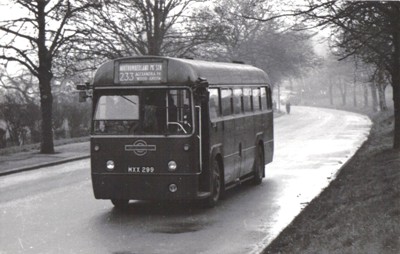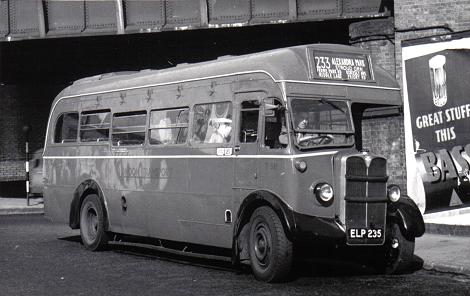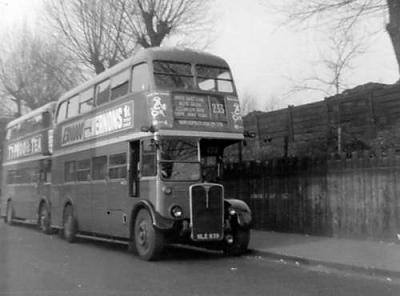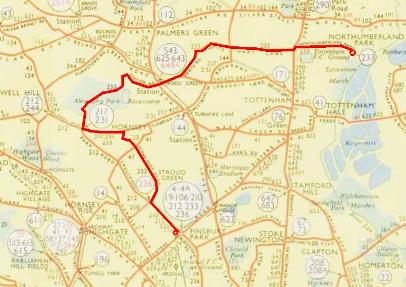|
|
 Red RF routes Red RF routes
Route 233
Page last updated 1 January 2017
Always a popular route with its scenic section through
Alexandra Park, the 233 was operated by West Green Garage until its
closure in 1962.
RF411 heads down from
Alexandra Palace towards Wood Green in 1958 or early 59, with
another RF following behind. Derek Reynolds and Ken
Stevens recall that behind the shrubbery on the left, and set a
little lower, was the hut used by Air Cadets; that used by the Sea
Cadets on the western side of the hill had a grey painted 2 or
3 pounder gun in front. Beyond the second bus was the
entrance to the Palace. Immediately behind the bus and
slightly to the right stood 'The Dive'. The road the other
side from the Palace, down to the foot of Muswell Hill at Priory
Road, passed the entrance to 'The Grove' with some nice tea
rooms. Beside the Western gates at the Priory Road end was a
Tea Van, very popular with crews.
Photo © N Rayfield, Peter
Gomm collection
Dates of RF operation
1 Feb 53 to 17 Mar 59
(total 6 years, 2 months, all crew operation).
Destinations
FINSBURY PARK Wells Terrace
and NORTHUMBERLAND PARK STATION
Reason for single-deck operation
The need for single-deckers
was two low bridges, one over Station Road, about
300 yards to the west of Wood Green underground station, and
the other at White Hart Lane Station. However, the busy
section between Finsbury Park and Muswell Hill Victoria
Hotel (also known as Alexandra Park Victoria Hotel)
was double-decked on Monday to Saturday from 7 Sep 55, extended to
Alexandra Palace The Dive on Saturday afternoons, and
Sundays from 16 Oct 55.
The Wood Green bridge carried the
old Great Eastern Railway branch from Seven Sisters that ran to
Palace Gates Station located east of the main line station, closed
in 1964. Before the closure of the Palace Gates line, the
road under the bridge was lowered in about 1958/9 to permit
double-deck operation. The site of the bridge is still
visible by virtue of the dip in the road.
The White Hart Lane bridge is believed
to have been rebuilt and raised when the line was realigned and
electrified at about the same time, although electrification was
not completed until 1960. The whole route was
double-decked on 18 Mar 59.

Route history
Introduced by the General as daily route 154 on 3 Feb 26, the
route ran initially between Finsbury Park and Muswell Hill
Victoria Hotel and was operated by Holloway Garage
(J) using K-class single-deckers. In June 1929, the route was
transferred to The London Public Omnibus Co at West Green
(WG) using Dennises, but Public were absorbed into the General
six months later. The Ds were replaced by Ts in 1933,
and in the 1934 renumbering, the
route became the 233. At that time, two tram services ran to
Alexandra Palace, one from the Victoria Hotel and one from Wood
Green; there was no road from end to end. Five LT Scooters
joined the Ts at WG in February 1938 to operate new route 241 between Wood Green LT Station and
Alexandra Palace East Gate to replace the tram
service.
Although the 233 was officially allocated Qs in
1952, the Central area received 40 former Green Line 10T10s that
had been replaced by RFs, and two were allocated to West Green for
the 233. One of the pair, T511, is seen on 25 June 1952,
newly-emerged from Chiswick in red livery but still with the Green
Line route board brackets. It sits at Wells Terrace, Finsbury
Park, waiting to depart on a short working for 'Alexandra
Park' - also known as Muswell Hill Victoria
Hotel. It was these short workings that were
converted to RTL operation in 1955.
Photo © Alan Cross, Peter Gomm
collection
Agreement was reached between the Palace authorities and London
Transport, under which LT contributed to the cost of a road along
the south side of the palace and the removal of the
tramlines. On 1 Jun 38, the 233 was extended through the
grounds from the Victoria Hotel to Wood Green, replacing the
western trams and the 241; at the same time it
was converted to 5Q5 operation, still from West
Green. The peak bus allocation doubled from 6 to 12.
The evening service through the park was suspended during
the winters from 1942/3 to 1944/5, the route then working in two
sections.
The 5Q5s typified the route for many years, but were not always
alone. T14 of the original type joined them in 1944/45, along
with periodic visits by 1/7T7/1s and 11T11s, both during and after
the war and 9T9s after the war. Occasional 4Q4s were
allocated, with green Q31 during 1947 and Qs 8, 44 and 53
(red), 67 and 68 (green) in August 1948. These were not
liked by the drivers who said they could not see the kerb,
and in November that year they were sent to Dalston for the
208. Finally, the 5Q5s were
supplemented by up to three 10T10s between March 1951 and
February 1953.
The route was further extended in October 1949 along White Hart
Lane to Northumberland Park. For many years, both before and
during RF operation, additional services were provided on summer
Sundays over the winter schedules.
On 1 Feb 53, no fewer than 20 brand new RFs were
delivered overnight from Chiswick and licensed; 16 5Q5s were
withdrawn the same night and five more moved elsewhere for further
service. The final two Qs were withdrawn on 2 February and
the final RF was licensed on 4 February.
 The need for single-deckers was a low bridge
over Station Road to the west of Wood Green underground
station. This carried the old Great Eastern Railway branch
from Seven Sisters that ran to
Palace Gates Station located east of the main line
station, closed in 1964. However, the busy section
between Finsbury Park and Muswell Hill Victoria Hotel
(also known as Alexandra Park Victoria Hotel) was
double-decked on Monday to Saturday from 7 Sep 55, extended to
Alexandra Palace The Dive on Saturday afternoons, and
Sundays from 16 Oct 55. The need for single-deckers was a low bridge
over Station Road to the west of Wood Green underground
station. This carried the old Great Eastern Railway branch
from Seven Sisters that ran to
Palace Gates Station located east of the main line
station, closed in 1964. However, the busy section
between Finsbury Park and Muswell Hill Victoria Hotel
(also known as Alexandra Park Victoria Hotel) was
double-decked on Monday to Saturday from 7 Sep 55, extended to
Alexandra Palace The Dive on Saturday afternoons, and
Sundays from 16 Oct 55.
Shortly after the
conversion from RTL to RT, Wood Green's RT4275
stands at Finsbury Park. Photo John Hinson
collection
RTLs from West Green were used for the short workings, replacing
RFs one-for-one (with an increase of one on Saturdays) to provide
extra capacity. A significant saving in the total number of
buses was however made when the route was double-decked
throughout. Before the closure of the Palace Gates line, the
road under the bridge was lowered to permit double-deck
operation and the whole route was converted from 18 Mar
59. The RFs displaced were distributed round the fleet, to
permit the commencement of the conversion of the first batch of red RFs for OMO working. The
RTLs were replaced in turn by RTs, just before the closure of
West Green on 2 Jan 62, the route being taken over by former
trolleybus depot Wood Green (WN).
The route was converted to flat-fare Merlin operation
and renumbered W3 in September 1968 (W5 with W6 on Saturdays),
as part of the 'Reshaping Plan' scheme for Wood
Green. The W3 became daily six months later, and the
Merlins were replaced by DMSs in 1974, then Ms in 1981. It
still runs over the RF route, still with a high frequency, now with
low-floor double-deckers.
 RF route in
detail RF route in
detail, with timing points
FINSBURY PARK Wells Terrace, Stroud Green Road,
Stroud Green
Stapleton, Stapleton Hall Road, Ferme Park Road,
Tottenham Lane, Rokesley Avenue (to 6 Dec 55) or Elmfield Avenue
(return via Rokesley Avenue), Middle Lane, Middle Lane Priory Road, Priory
Road, Muswell Hill Victoria
Hotel, Private road through Alexander Park grounds,
Bedford Road, Bridge Road, Buckingham Road, Wood Green ER Station (now
Alexandra Park Station), Station Road, Wood Green LT Station, Lordship
Lane, Perth Road, White Hart Lane, Great Cambridge Road White Hart
Lane, White Hart Lane, Creighton Road, White Hart Lane,
High Road Tottenham, Northumberland Park, NORTHUMBERLAND PARK
STATION
1955 bus map © London
Transport
Terminal workings: Finsbury Park - see separate page. Northumberland Park - stand
in Northumberland Park, north west of Willoughby Lane. Depart
via Shelbourne Road, Manor Road, Chalgrove Road, Northumberland
Grove.
Short working termini:
Wood Green LT Station - turning point only
via Lordship Lane, Redvers Road, Buller Road, High
Road;
Wood Green ER Station - turning circle and stand in
Bedford Road;
Alexandra Palace - stand outside café in car park;
Muswell Hill Victoria Hotel - stand in Approach Road
close to junction with Priory Road.
Garage workings: as the 1959 timetable shows buses entering
and leaving service at both Wood Green Station, ER and
Middle Lane Priory Road, we may deduce that buses ran from
West Green along Turnpike Lane and High Road, respectively.
It is not known ( or is it?)
whether these workings operated in service.
Frequency
| Year |
Mon-Fri |
Sat |
Sun |
| 1936 |
5-6 mins |
5-6 mins |
7½-10 mins |
| 1938 |
5-6 mins |
5-6 mins |
7½-10 mins |
| 1941 |
7½-15 mins
*† |
7½-15 mins
*† |
10-15 mins |
| 1946 |
12-15 mins *‡ |
15 mins *‡ |
6-8 mins |
| 1951 |
6-8 mins * |
5-6 mins * |
10-15 mins * |
| 1953 |
6-8 mins * |
4-6 mins |
10-15 mins * |
| 1959 |
7-10 mins * |
5-15 mins * |
10-12 mins * |
* more frequent Finsbury Park - Muswell Hill
Victoria Hotel
† more frequent Alexandra Park - Wood Green Und
Station
‡ more frequent Wood Green LNER Station - Wood
Green Underground Station
From Finsbury Park, the route took about 37 minutes to
reach Northumberland Park. Wood Green Underground
Station was 23 minutes from Finsbury Park.
RF allocation
New RFs delivered Feb 53: 423-435, 438, 454, 456-461,
+ 292, 301 second hand (total 22 + 1 spare)
PVR 1953 (Feb): Mon-Fri 22, Sat 21, Sun 19
PVR 1953 (May): Mon-Fri 22, Sat 21, Sun 21
PVR 1953 (Oct): Mon-Fri 22, Sat 21, Sun 19
PVR 1954 (May): Mon-Fri 22, Sat 21, Sun 21
PVR 1954 (Oct): Mon-Fri 22, Sat 21, Sun 19
PVR 1955 (Feb): Mon-Fri 22, Sat 21, Sun 17
PVR 1955 (May): Mon-Fri 22, Sat 21, Sun 19
PVR 1955 (Sep): Mon-Fri 16 + 6 RTL, Sat 17 + 5 RTL, Sun
19
PVR 1955 (Oct): Mon-Fri 16 + 6 RTL, Sat 17 + 5 RTL, Sun
10 + 4 RTL
PVR 1956 (May): Mon-Fri 16 + 6 RTL, Sat 17 + 5 RTL, Sun
12 + 5 RTL
PVR 1956 (Oct): Mon-Fri 16 + 6 RTL, Sat 17 + 5 RTL,
Sun 8 + 4 RTL
PVR 1957 (May): Mon-Fri 16 + 6 RTL, Sat 17 + 5 RTL, Sun
12 + 5 RTL
PVR 1957 (Oct): Mon-Fri 16 + 6 RTL, Sat 17 + 5 RTL,
Sun 8 + 4 RTL
PVR 1958 (May): Mon-Fri 16 + 6 RTL, Sat 17 + 5 RTL, Sun
12 + 5 RTL
PVR 1958 (Oct): Mon-Fri 16 + 6 RTL, Sat 17 + 5 RTL,
Sun 10 + 5 RTL
PVR 1958 (Nov): Mon-Fri 15 + 6 RTL, Sat 17 + 5 RTL,
Sun 8 + 4 RTL
Derek Reynolds grew up in
Wood Green. He wrote of his memories in the Newsletter of the
Friends of Classic London Buses of the Fifties. Thanks to
Derek for permission to reproduce his recollection of the
233:
Another occasional treat was
taking the little red RF on route 233 from outside the dance hall
to 'The Dive' at Alexandra Palace. The bus fare was one penny
adult, halfpenny child, and the RF would take off up Station Road,
past the corset factory, under the branch line to Palace Gates,
past the United Dairies depot ringing with the sound of wire crates
full of empty bottles - and the smell of horses, and hay - up
past the common with Barratts sweet factory pouring out some awful
smells (what were sweets made of?), over the New River which
disappeared into a spooky black tunnel, alongside Wood Green main
line station maybe catching a glimpse of clanking steam in the
cutting, then over the railway, back up the other side of it, and
through the gates into the Palace grounds and the long climb, which
the RF had to take in first gear. We boys would run alongside
faster, but as the vista opened up the higher we climbed, the RF
was better. I don't recall doors on these RFs and subsequently
learned many red ones had none.
 Getting off at The Dive was the
start of playtime - a trip on the miniature railway, or in the
paddle boats, and some time at the semi-permanent fair. Then a walk
around the veranda of 'Ally Pally', roll down the slopes in fresh
cut grass, or just sit and spy the dome of St. Paul's Cathedral,
and the white plumes of steam engines trailing along past the
reservoirs and filter beds from Hornsey through Wood Green. ‘The
Dive' was a cafe at the top of the hill, just inside the entrance
to the palace forecourt. It was built of corrugated iron - or at
least ways clad in it, and painted dark green. Shaded under some
big old trees it was quite a secluded retreat. In the evenings it
was the haunt of Teddy boys and rockers who would roar up the hill
on their Gold Stars and Nortons, Vauxhall Crestas and Ford Zodiacs.
I loved the sound of those Gold Stars.
Ken
Stevens also fondly remembers the RFs, 'the 233 being my
commuting route from Priory Road to Finsbury Park Station or, in
earlier life, over the Palace to Wood Green either for the pictures
at the Gaumont or to catch the Eastern National 251 service from
Wood Green bus station for a day out at Southend; occasionally we
would take the 233 to Finsbury Park to connect to the 210 for a
trip to Hampstead Heath. Doors were certainly non-existent on
that route and sitting in front seats was an experience to be
avoided if possible on a winter’s day. I used the W3
Merlin replacement service for a year or two before moving away
from London, but wasn’t impressed – it was a characterless cattle
truck!'
RF486 southbound at
Alexandra Palace in 2005.
Photo © Peter
Osborn
Re-creation
The 60th anniversary of RFs was marked by a road run on Sunday 17 February 2013. In
addition, RF486, which worked the 233 between 1957 and 1959, ran
over part of the route in 2005.
|
|